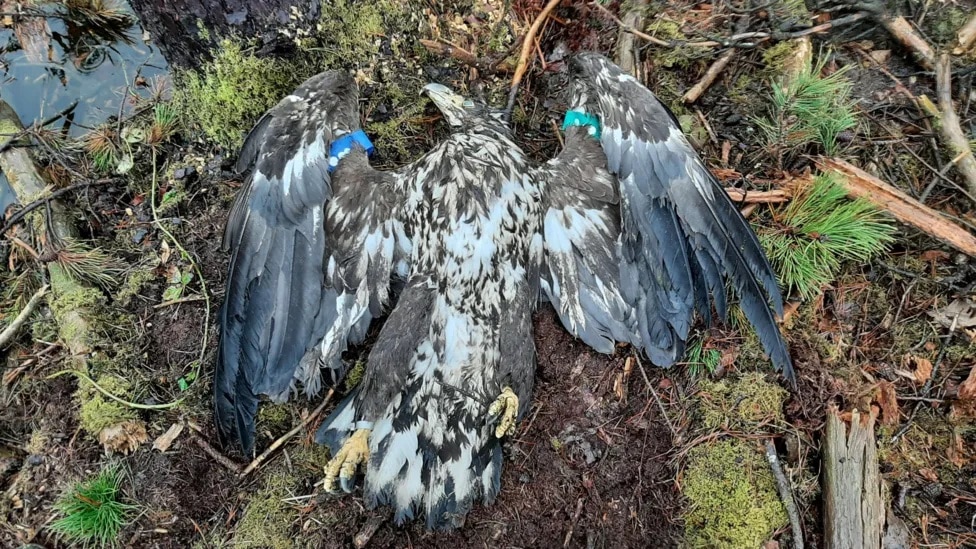A young female White-tailed Eagle was found shot dead in Ireland last week. Part of a long-running national reintroduction programme run by the National Parks and Wildlife Service (NPWS) she had been released at Lough Derg, Co Donegal two years ago, and was found by Cranberry Lough 180km to the south.
All eagles from the reintroduction programme are fitted with satellite tags before release that allow researchers to track their movements. GPS data showed that since release in 2022 she had travelled to the river Shannon estuary in Limerick, headed north up through the Burren in County Clare, then arrived in Donegal in mid-April 2023. In 2024, she had spent most of her time along the borders between Galway, Offaly and Roscommon before being shot on 11 or 12 March.

Irish Minister of State for Nature, Heritage and Electoral Reform, Malcolm Noonan, said he was devastated by news of the death “of one of our beloved White-tailed Eagles” saying:
“These majestic birds have been part of a reintroduction project to restore their populations in Ireland and to think that one would be shot is unconscionable.“
Last year, a police investigation was launched after two White-tailed Eagles were found illegally poisoned on moorland at Glenwherry Hill farm in County Antrim, close to Northern Ireland’s only commercial grouse shoot.
The birds were killed with Bendiocarb, an acutely toxic insecticide that senior RSPB Investigator Guy Shorrock described in 2021 as “the poisoner’s weapon of choice” and which has been used in a series of raptor persecution incidents.
White-tailed Eagles
Britain and Ireland’s largest birds of prey with a wingspan of up to 2.5m (8.2ft), most countries across the White-tailed Eagles huge range live quite happily with them. Sadly – as is so often the case – that’s not been the story here in the UK. Widespread but never especially common (these huge birds are right at the top of the food chain and require large territories), the species was heavily persecuted for years by gamekeepers, fishery owners and shepherds, and also suffered from skin and egg collectors. The last known English pair bred on Culver Cliff on the Isle of Wight in 1780. Following its extirpation from Ireland in 1901, White-tailed Eagles were lost entirely to the British Isles in 1918, when the last Scottish bird (a female) was shot in Shetland.
In 1975 a reintroduction programme was launched in Scotland in a bid to bring this majestic raptor back home. Eighty-two young birds from Norwegian nests were brought to Rum between 1975 and 1985 and then others to Wester Ross between 1993 and 1998. The first chick from the programme fledged in 1985 when a pair bred successfully on the Isle of Mull. A 2019 report concluded that visitors to Mull spend between £4.9 million and £8 million every year coming to see the now-established and thriving population of White-tailed Eagles.
In Ireland a reintroduction programme saw the release between 2007-2011 of 100 young White-tailed Eagles (also from Norway) in Killarney National Park, County Kerry. The released eagles subsequently dispersed widely throughout Ireland with the first successful breeding occurring in 2012 on Lough Derg, County Clare.
In 2020, the NPWS began a second phase reintroduction project with the release of young eagles at several sites, including Lough Derg, the lower Shannon estuary and Killarney National Park.

NPWS stress the importance of “cooperation with the farming communities in the release areas and where birds settle to breed”. They say that during the first phase of the release project, managed by the NPWS and the Golden Eagle Trust, a good relationship was established with the farming community, with farmers helping to monitor birds and nests at some nesting sites.
As is so often the case though, once a previously very rare bird of prey starts to recover its numbers someone will decide that ‘enough is enough’ and take the law into their own hands. In early 2022, two White-tailed Eagles reintroduced by the Roy Dennis Wildlife Foundation onto the Isle of Wight were found dead on two unnamed shooting estates in Dorset and West Sussex. Both had been poisoned.
The Dorest incident prompted local MP Chris Loder (a farmer and landowner) to take to social media to post a tweet that appeared to tell police not to investigate what was a serious wildlife crime, saying (wrongly) that in his opinion ‘Eagles don’t belong in Dorset’.
We can only hope that Loder’s ignorant and antiquated attitude has not taken root in Ireland as well…
(Header image of the shot white-tailed Eagle by National Parks and Wildlife Service)

